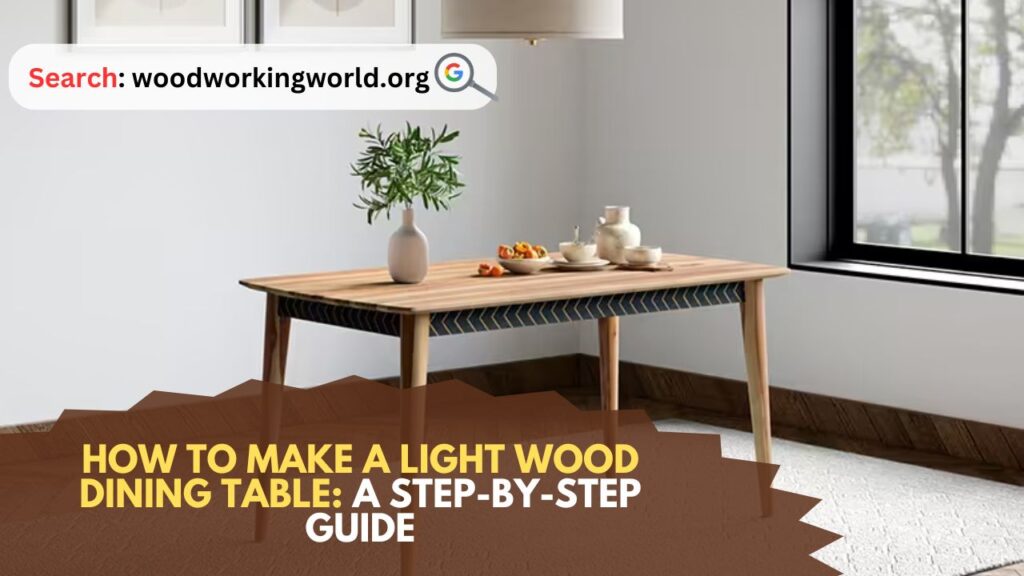Light Wood Dining Table: Creating your own light wood dining table is a rewarding woodworking project that combines practicality with aesthetics. Whether you’re a seasoned woodworker or a beginner, this guide will walk you through the entire process, from selecting the right wood to adding the finishing touches. Let’s get started on crafting a beautiful piece that will be the centerpiece of your dining room.

How to Make a Light Wood Dining Table
Materials and Tools You Will Need to Make a Light Wood Dining Table
Materials:
- Light wood lumber (such as pine, birch, or maple)
- Wood glue
- Screws or nails
- Sandpaper (various grits)
- Wood stain or paint (optional)
- Clear finish (polyurethane or varnish)
Tools:
- Tape measure
- Circular saw or table saw
- Miter saw
- Power drill
- Clamps
- Orbital sander
- Screwdriver
- Paintbrushes or rags
Step 1: Planning and Designing Your Table
Before you start cutting any wood, it’s essential to have a clear plan and design. Determine the dimensions of your dining table based on the space available in your dining area and the number of people you want to seat. A standard dining table is usually 30 inches high, 36-40 inches wide, and 72 inches long, but you can adjust these measurements to fit your needs.
Sketch your table design, including the tabletop and the legs. Decide whether you want a simple rectangular table or a more complex design with decorative elements.
Step 2: Selecting the Wood
Choose light wood for your dining table. Pine, birch, and maple are excellent options due to their strength and attractive grain patterns. Ensure the wood is kiln-dried to prevent warping and cracking over time.
Visit a local lumber yard or home improvement store to select your wood. Inspect each piece for straightness, knots, and defects. It’s a good idea to purchase a little more wood than you need to account for any mistakes or imperfections.
Step 3: Cutting the Wood
Cutting the Tabletop
- Measure and Mark: Measure and mark the dimensions of your tabletop on the wood. Use a straight edge to ensure accurate lines.
- Cut the Wood: Use a circular saw or table saw to cut the wood to the desired dimensions. If your tabletop is made from multiple boards, ensure they are all cut to the same length.
- Join the Boards: If you’re using multiple boards, join them together using wood glue and clamps. Apply glue to the edges of the boards, align them, and clamp them tightly. Allow the glue to dry according to the manufacturer’s instructions.
- Sand the Surface: Once the glue has dried, use an orbital sander to sand the tabletop. Start with coarse-grit sandpaper to remove any rough spots, then progress to finer grits for a smooth finish.
Cutting the Legs and Supports
- Measure and Mark: Measure and mark the dimensions for the legs and any additional supports. Standard table legs are usually 29 inches long to achieve a total table height of 30 inches.
- Cut the Legs: Use a miter saw to cut the legs to the desired length. Ensure all legs are the same length for stability.
- Cut the Supports: If your design includes cross supports or an apron (the frame that supports the tabletop), cut these pieces to the appropriate length and width.
Step 4: Assembling the Table
Assembling the Frame
- Build the Frame: Lay out the legs and supports according to your design. Attach the supports to the legs using wood glue and screws or nails. Ensure the frame is square by measuring the diagonals; they should be equal.
- Attach the Apron: If your table includes an apron, attach it to the inside edges of the frame. This will provide additional support for the tabletop.
Attaching the Tabletop
- Position the Tabletop: Place the assembled frame upside down on the underside of the tabletop. Center the frame to ensure even overhang on all sides.
- Attach the Tabletop: Secure the tabletop to the frame using screws. Pre-drill holes to prevent splitting the wood. Use screws that are long enough to secure the tabletop but not so long that they protrude through the top surface.
Step 5: Sanding and Finishing
Sanding
- Final Sanding: Once the table is assembled, perform a final sanding to smooth out any rough edges and ensure a uniform surface. Start with medium-grit sandpaper and progress to fine-grit sandpaper.
Staining or Painting (Optional)
- Choose Your Finish: If you want to enhance the natural beauty of the wood, apply a wood stain. Choose a color that complements your dining room decor. Alternatively, you can paint the table for a more modern or rustic look.
- Apply the Stain or Paint: Follow the manufacturer’s instructions for applying the stain or paint. Use a brush or rag to apply the stain in the direction of the grain. For paint, use a brush or roller for an even coat. Allow the stain or paint to dry completely.
Applying a Clear Finish
- Select a Finish: Choose a clear finish such as polyurethane or varnish to protect the wood and give it a polished look.
- Apply the Finish: Use a brush to apply the clear finish in thin, even coats. Allow each coat to dry according to the manufacturer’s instructions before applying the next. Sand lightly between coats with fine-grit sandpaper for a smooth finish.
Step 6: Final Touches
Inspect Your Work
- Check for Rough Spots: Inspect the entire table for any rough spots or areas that need additional sanding.
- Ensure Stability: Make sure the table is stable and does not wobble. Adjust the legs if necessary.
Add Felt Pads
- Protect Your Floors: Attach felt pads to the bottom of the table legs to prevent scratching your floors and to make it easier to move the table.
Step 7: Enjoy Your New Dining Table
Congratulations! You’ve successfully built a beautiful light wood dining table. Invite your family and friends over to admire your craftsmanship and enjoy meals together around your new creation.
Conclusion: Light Wood Dining Table
- Take Your Time: Rushing through the project can lead to mistakes. Take your time to ensure each step is done correctly.
- Safety First: Always wear safety goggles and ear protection when using power tools. Work in a well-ventilated area when applying stains and finishes.
- Ask for Help: If you’re unsure about any step in the process, don’t hesitate to ask for help from a more experienced woodworker or refer to online tutorials and resources.
By following these steps and tips, you’ll create a light wood dining table that is not only functional but also a beautiful addition to your home. Happy woodworking!
I hope this article on Light Wood Dining Table has been helpful. If you have any further questions, please feel free to leave a comment below.
Video
